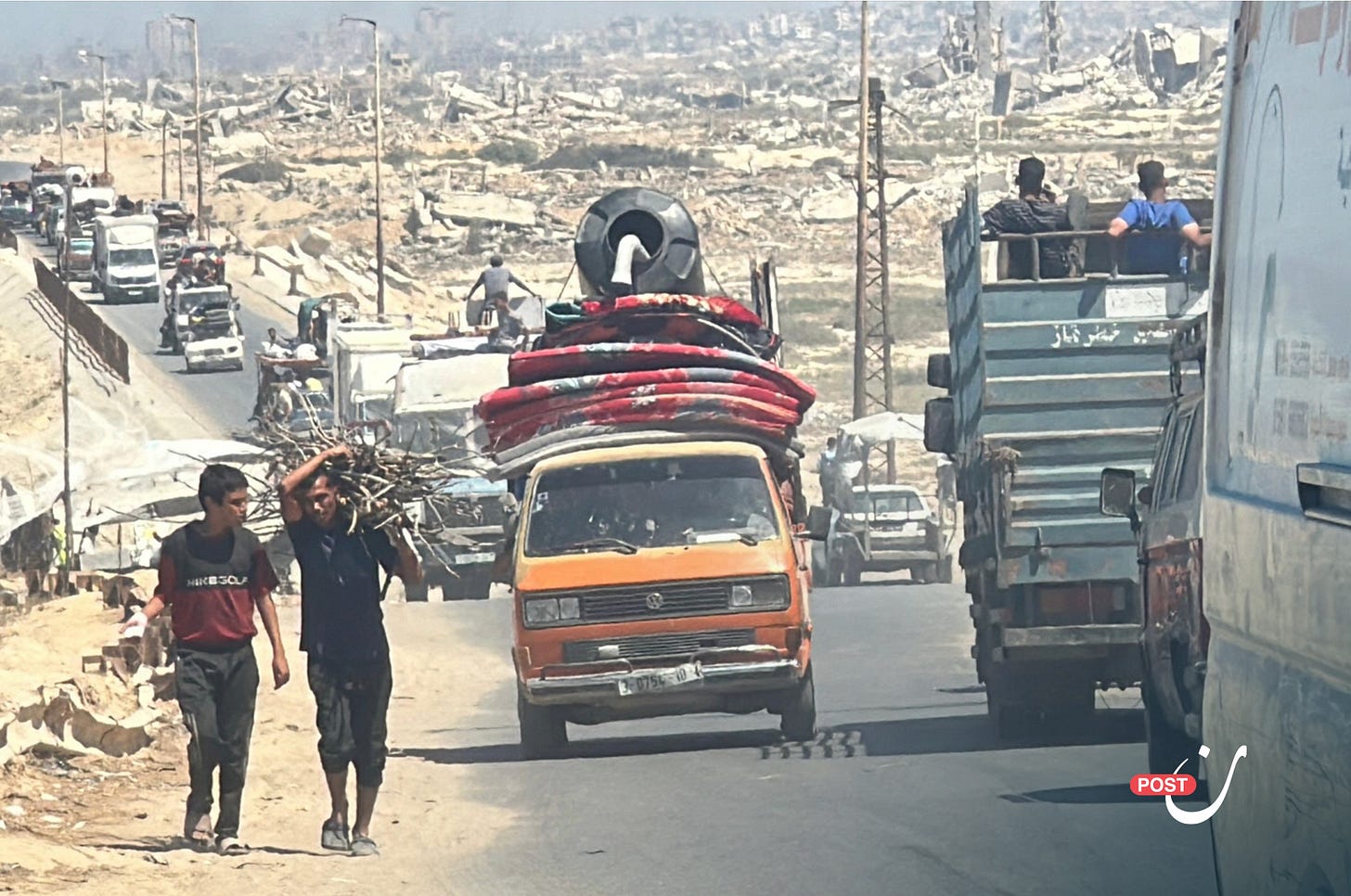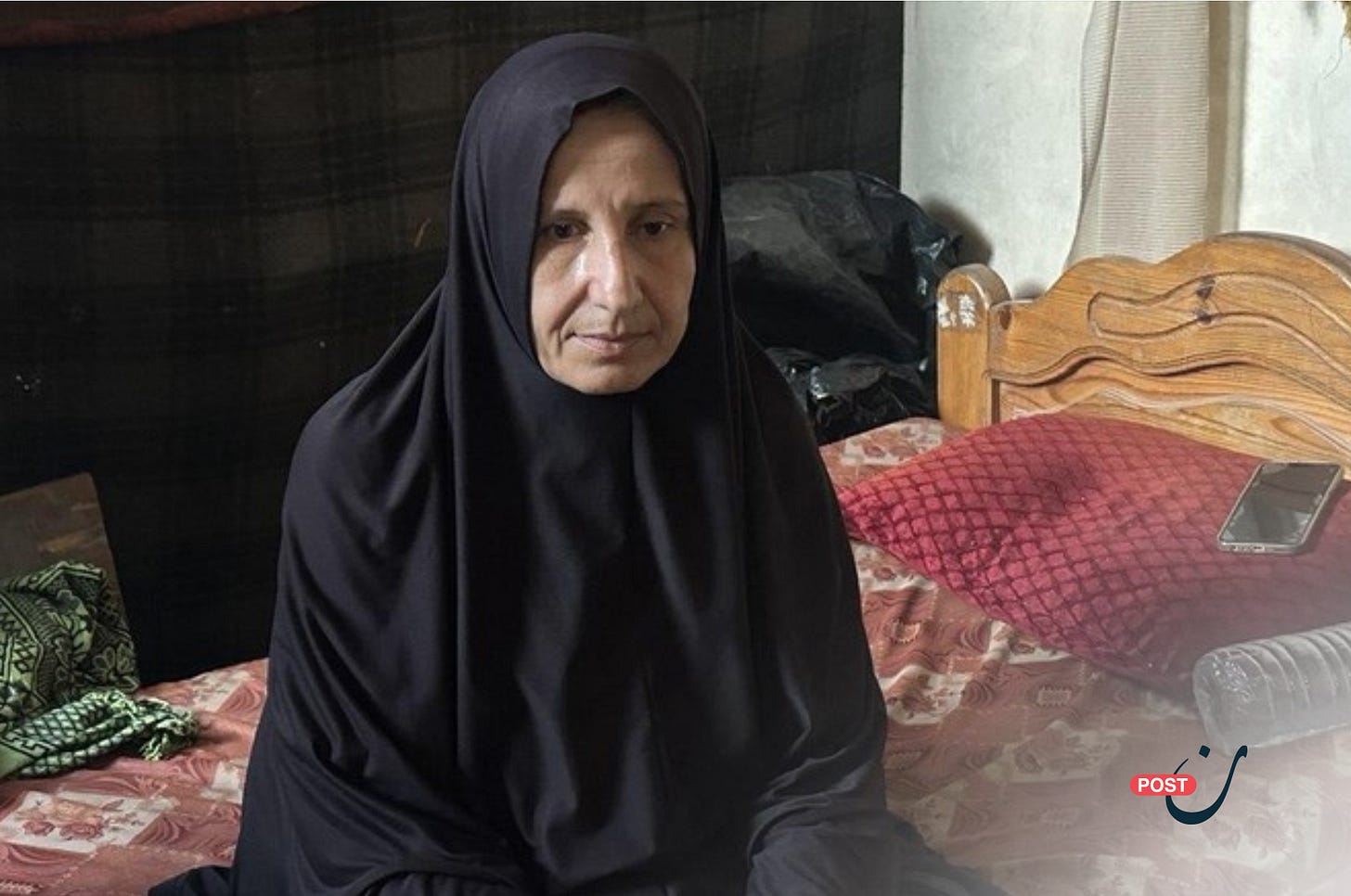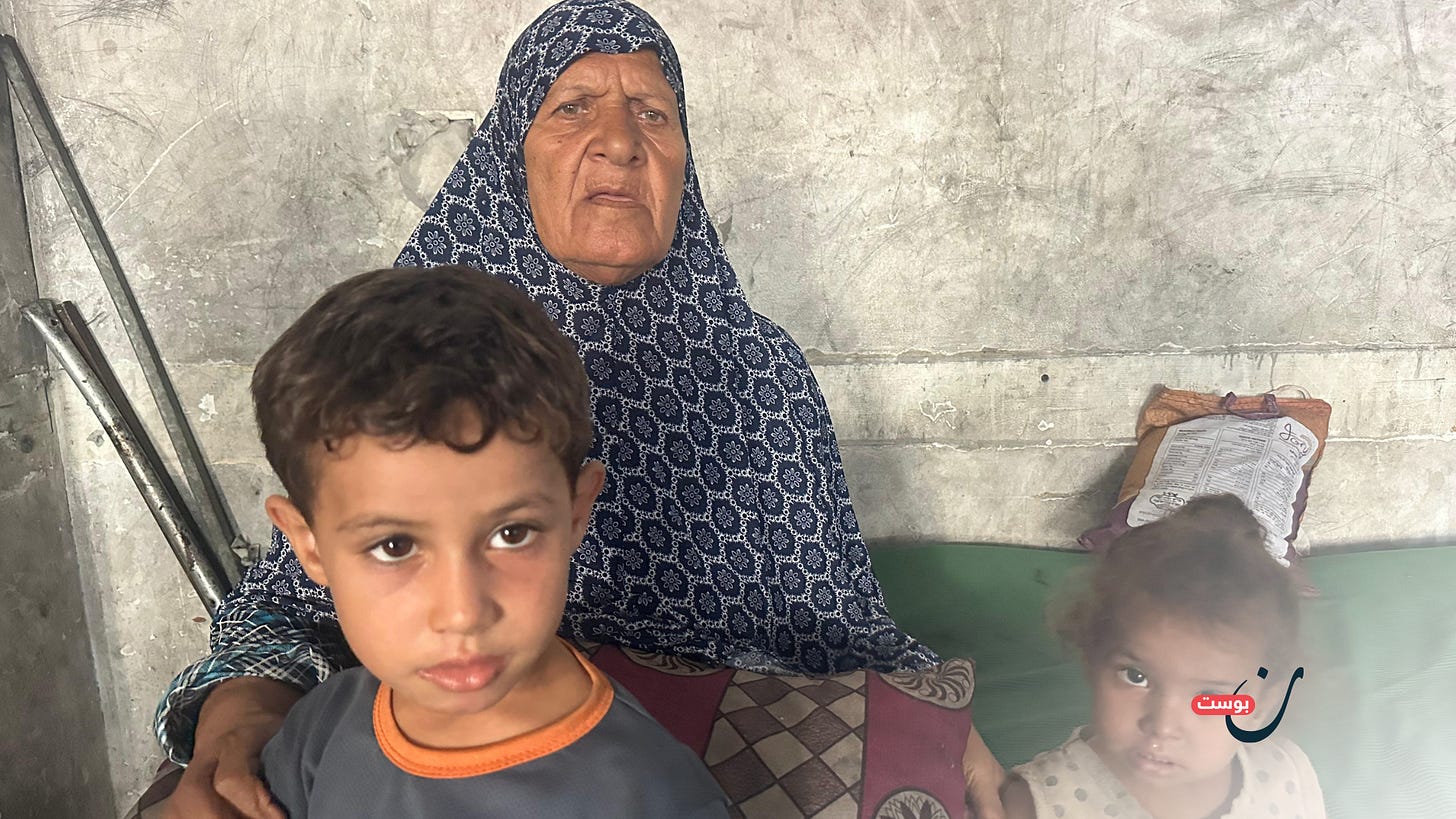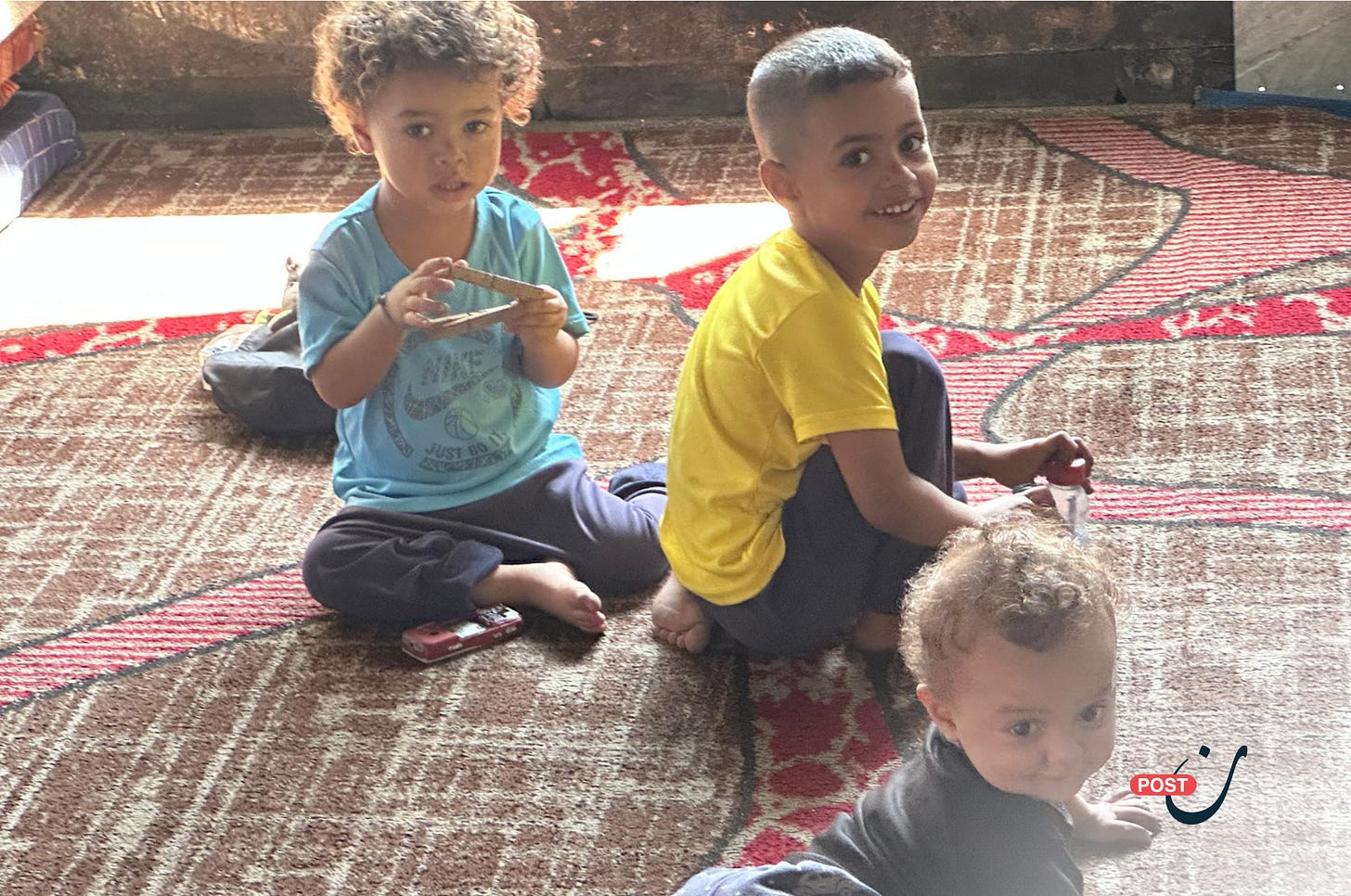Amid relentless bombardment and endless evacuation orders, dozens of Palestinian families in Gaza City have begun a new phase of displacement toward central and southern areas of the Strip.
Their suffering, now entering its second year, continues unabated. At the same time, other families have chosen to stay despite the fear, believing that dying in their homes is less painful than the torment of displacement to an unknown fate a journey marked not by safety or survival, but by death and targeting. There is no safe place in Gaza, despite Israel’s claims; its bombs reach every corner.
In one of the narrow corridors of a displacement shelter in central Khan Younis, Um Tamer Issa, 58, sits silently. She was displaced from Izbat Abd Rabbo in northern Gaza, and is still enduring the pain of a severe injury caused by an Israeli strike in the Zeitoun neighborhood, south of Gaza City. A piece of shrapnel pierced her back and exited through her abdomen.
With the collapse of Gaza’s healthcare system and a critical shortage of medical staff and supplies, she bled for days without proper treatment.
Um Tamer recounts that she has been displaced around fifteen times, moving from one Gaza neighborhood to another from the north to central Gaza, then to Rafah and Khan Younis in the south. Her brief return to the north during the truce on January 19 offered a fleeting sense of relief, only to be shattered as Israel resumed its offensive with even greater ferocity.
She once again embarked on the painful journey of displacement, this time with her elderly, immobile husband and several family members, under bombardment and fear, stripped of all belongings. A relative finally took them in at a shelter.
Speaking to Noon Post, Um Tamer describes the ordeal of displacement as “a piece of torment.” Transportation costs are exorbitant, and her family is financially destitute, having relied before the war on the daily wages of her sons, without any stable income.
Those with bank accounts have drained them buying essentials like wooden beams, tarps, kitchen utensils, and makeshift bathrooms for tents. “Can you imagine?” she says, “Every time we begin to settle, pitch a tent, set up a bathroom, and try to adapt the occupation surprises us with new evacuation orders. And the nightmare starts all over again.”
Elsewhere in the shelter, 29-year-old Amira Shallakh sits with her four children, mourning her husband. He had fled with the family to the south to protect them from airstrikes, but returned to their home in northern Gaza where he was killed. Amira and her children never saw him again, never got to say goodbye.
He died in the north, while they grieved him in the south. In this war, there is no time for mourning — and no space for farewells.
Amira recalls the unbearable pain of losing her husband and not being able to bid him farewell. The decision to flee was his, made out of fear for his family’s safety as airstrikes escalated and residential towers were targeted.
The bombing of the Mushtaha Tower just across from their home in western Gaza City felt like an earthquake, destroying the building and its surroundings. It forced the family to borrow money just to cover the cost of fleeing to the south.
Their displacement journey has been riddled with trauma. Every time they try to settle, a new evacuation order comes. And so they move again, carrying whatever meager belongings they managed to gather, with almost no money.
Amira now faces another battle: raising four children alone and trying to provide them with life’s bare essentials. For her, this daily fight for survival is no less brutal than the war itself.
For 76-year-old Fatima Suhweil from Beit Hanoun, the displacement ordeal has also exceeded fifteen times. She walked long distances between towns Beit Hanoun, downtown Gaza, Jabalia, Beach Camp, Friends of the Patient Hospital, Nuseirat, Rafah, Khan Younis, Zawaida, and Gaza City searching for safety in a place where none exists.
Speaking to Noon Post, she explains that displacement is only part of the suffering. A famine-like situation has gripped Gaza for months. Bodies are too weak for even the simplest physical effort due to malnutrition and low blood pressure.
Essential foods meat, poultry, fruits, vegetables have been banned from entering Gaza for over six months. Fatima recalls collapsing in the street during one of her displacement journeys, exhausted and malnourished. Her chronic illnesses remain untreated, as medications are no longer available in Gaza.
Similarly, 31-year-old Sahar al-Masri fled Gaza City for Khan Younis with her husband’s family. Her own family stayed behind in the north, hoping to find a patch of land to pitch their tents. Her youngest uncle, Ibrahim, was tasked with securing shelter. But he was killed in Deir al-Balah during the search the very area Israel designates as a so-called “humanitarian zone.”
After Ibrahim’s death, her extended family more than fifty people refused to evacuate, realizing the Israeli military strikes everywhere, including in areas it claims are “safe.” For Sahar, no place in Gaza is safe.
She expresses a desperate hope that the war will end before winter. The coming season threatens to bring new suffering to thousands living in flimsy tents. Many have been displaced since summer and have no winter clothing or supplies to shield them from the cold.
In an exclusive statement to Noon Post, Ismail al-Thawabteh, head of the Government Media Office in Gaza, said that Gaza City is home to roughly 914,556 people, with around 51,544 multi-story apartment buildings. This means that targeting a single tower is equivalent to destroying an entire residential neighborhood and displacing dozens of families.
Meanwhile, the Israeli army continues to issue repeated evacuation warnings targeting residential buildings and towers. It has also ordered a full evacuation of Gaza City, urging residents to head south via the coastal Rashid Street “without inspection,” as it expands its ground offensive — “Gideon Chariots 2” — aimed at occupying the city entirely.
On Facebook, the Israeli government’s Coordinator of Activities in the Territories claimed the army is “carrying out operations to dismantle Hamas in Gaza City,” adding: “Starting now, and to ease the departure of residents, we declare al-Mawasi in Khan Younis a humanitarian zone where humanitarian services will be provided.”
In another statement, the Israeli military reiterated that it was expanding the ground operation under “Gideon Chariots 2,” again designating al-Mawasi as a “humanitarian zone” — even as it continues to strike those fleeing to these very areas.
The army claimed that this “humanitarian area” includes basic infrastructure: field hospitals, water lines, desalination facilities, food supplies, tents, medicines, and medical aid — supposedly coordinated with international agencies.
In stark contrast, Gaza’s Ministry of Health reported that from October 7, 2023, to September 9, 2025, between 64,600 and 65,500 people have been killed, and between 163,000 and 171,000 injured — most of them women and children. Over 9,000 remain missing.
Moreover, between 376 and 399 have died from malnutrition, including around 140 children, as Israel continues its deadly assault on Gaza’s two million residents. Homes, hospitals, shelters, and even aid distribution points are all being relentlessly targeted.







